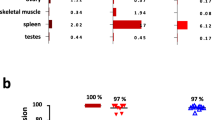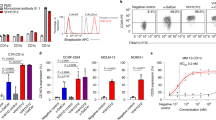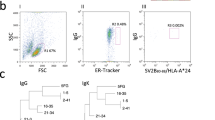Abstract
The purpose of these studies was to identify human leukocyte antigen (HLA)-A2+ immunogenic peptides derived from XBP1 antigens to induce a multiple myeloma (MM)-specific immune response. Six native peptides from non-spliced XBP1 antigen and three native peptides from spliced XBP1 antigen were selected and evaluated for their HLA-A2 specificity. Among them, XBP1184−192, XBP1 SP196−204 and XBP1 SP367−375 peptides showed the highest level of binding affinity, but not stability to HLA-A2 molecules. Novel heteroclitic XBP1 peptides, YISPWILAV or YLFPQLISV, demonstrated a significant improvement in HLA-A2 stability from their native XBP1184−192 or XBP1 SP367−375 peptide, respectively. Cytotoxic T lymphocytes generated by repeated stimulation of CD3+ T cells with each HLA-A2-specific heteroclitic peptide showed an increased percentage of CD8+ (cytotoxic) and CD69+/CD45RO+ (activated memory) T cells and a lower percentage of CD4+ (helper) and CD45RA+/CCR7+ (naïve) T cells, which were distinct from the control T cells. Functionally, the cytotoxic T lymphocytes (CTL) demonstrated MM-specific and HLA-A2-restricted proliferation, interferon-γ secretion and cytotoxic activity in response to MM cell lines and importantly, cytotoxicity against primary MM cells. These data demonstrate the distinct immunogenic characteristics of unique heteroclitic XBP1 peptides, which induce MM-specific CTLs and highlights their potential application for immunotherapy to treat the patients with MM or its pre-malignant condition.
This is a preview of subscription content, access via your institution
Access options
Subscribe to this journal
Receive 12 print issues and online access
$259.00 per year
only $21.58 per issue
Buy this article
- Purchase on Springer Link
- Instant access to full article PDF
Prices may be subject to local taxes which are calculated during checkout







Similar content being viewed by others
References
Kumar S . Multiple myeloma-current issues and controversies. Cancer Treat Rev 2010; 36 (Suppl 2): S3–S11.
Laubach JP, Richardson PG, Anderson KC . The evolution and impact of therapy in multiple myeloma. Med Oncol 2010; 27 (Suppl 1): S1–S6.
Jagannath S, Kyle RA, Palumbo A, Siegel DS, Cunningham S, Berenson J . The current status and future of multiple myeloma in the clinic. Clin Lymphoma Myeloma Leuk 2010; 10: 28–43.
Bensinger WI . Role of autologous and allogeneic stem cell transplantation in myeloma. Leukemia 2009; 23: 442–448.
Zeiser R, Finke J . Allogeneic haematopoietic cell transplantation for multiple myeloma: reducing transplant-related mortality while harnessing the graft-versus-myeloma effect. Eur J Cancer 2006; 42: 1601–1611.
Abdalla AO, Kokhaei P, Hansson L, Mellstedt H, Osterborg A . Idiotype vaccination in patients with myeloma reduced circulating myeloma cells (CMC). Ann Oncol 2008; 19: 1172–1179.
Lee JJ, Choi BH, Kang HK, Park MS, Park JS, Kim SK et al. Induction of multiple myeloma-specific cytotoxic T lymphocyte stimulation by dendritic cell pulsing with purified and optimized myeloma cell lysates. Leuk Lymphoma 2007; 48: 2022–2031.
Vasir B, Borges V, Wu Z, Grosman D, Rosenblatt J, Irie M et al. Fusion of dendritic cells with multiple myeloma cells results in maturation and enhanced antigen presentation. Br J Haematol. 2005; 129: 687–700.
Reimold AM, Iwakoshi NN, Manis J, Vallabhajosyula P, Szomolanyi-Tsuda E, Gravallese EM et al. Plasma cell differentiation requires the transcription factor XBP1. Nature 2001; 412: 300–307.
Shaffer AL, Lin KI, Kuo TC, Yu X, Hurt EM, Rosenwald A et al. Blimp-1 orchestrates plasma cell differentiation by extinguishing the mature B cell gene expression program. Immunity 2002; 17: 51–62.
Liou HC, Boothby MR, Finn PW, Davidon R, Nabavi N, Zeleznik-Le NJ et al. A new member of the leucine zipper class of proteins that binds to the HLA DR alpha promoter. Science 1990; 247: 1581–1584.
Yoshida H, Matsui T, Yamamoto A, Okada T, Mori K . XBP1 mRNA is induced by ATF6 and spliced by IRE1 in response to ER stress to produce a highly active transcription factor. Cell 2001; 107: 881–891.
Calfon M, Zeng H, Urano F, Till JH, Hubbard SR, Harding HP et al. IRE1 couples endoplasmic reticulum load to secretary capacity by processing the XBP1 mRNA. Nature 2002; 415: 92–96.
Lee K, Tirasophon W, Shen X, Michalak M, Prywes R, Okada T et al. IRE1-mediated unconventional mRNA splicing and S2P-mediated ATF6 cleavage merge to regulate XBP1 in signaling the unfolded protein response. Genes Dev 2002; 16: 452–466.
Mori K . Frame switch splicing and regulated intramembrane proteolysis: key words to understand the unfolded protein response. Traffic 2003; 4: 519–528.
Bagratuni T, Wu P, Gonzalez de Castro D, Davenport EL, Dickens NJ, Walker BA et al. XBP1s levels are implicated in the biology and outcome of myeloma mediating different clinical outcomes to thalidomide-based treatments. Blood 2010; 116: 250–253.
Patterson J, Palombella VJ, Fritz C, Normant E . IPI-504, a novel and soluble HSP-90 inhibitor, blocks the unfolded protein response in multiple myeloma cells. Cancer Chemother Pharmacol 2008; 61: 923–932.
Acosta-Alvear D, Zhou Y, Blais A, Tsikitis M, Lents NH, Arias C et al. XBP1 controls diverse cell type- and condition-specific transcriptional regulatory networks. Mol Cell 2007; 27: 53–66.
Wen XY, Stewart AK, Sooknanan RR, Henderson G, Hawley TS, Reimold AM et al. Identification of c-myc promoter-binding protein and X-box binding protein 1 as interleukin-6 target genes in human multiple myeloma cells. Int J Oncol 1999; 15: 173–178.
Davies FE, Dring AM, Li C, Rawstron AC, Shammas MA, O’Connor SM et al. Insights into the multistep transformation of MGUS to myeloma using microarray expression analysis. Blood 2003; 102: 4504–4511.
Zhan F, Hardin J, Kordsmeier B, Bumm K, Zheng M, Tian E et al. Global gene expression profiling of multiple myeloma, monoclonal gammopathy of undetermined significance, and normal bone marrow plasma cells. Blood 2002; 99: 1745–1757.
Iwakoshi NN, Lee AH, Vallabhajosyula P, Otipoby KL, Rajewsky K, Glimcher LH . Plasma cell differentiation and the unfolded protein response intersect at the transcription factor XBP1. Nat Immunol 2003; 4: 321–329.
Pal R, Janz M, Galson DL, Gries M, Li S, Jöhrens K et al. C/EBPbeta regulates transcription factors critical for proliferation and survival of multiple myeloma cells. Blood 2009; 114: 3890–3898.
Zhang K, Wong HN, Song B, Miller CN, Scheuner D, Kaufman RJ . The unfolded protein response sensor IRE1alpha is required at 2 distinct steps in B cell lymphopoiesis. J Clin Invest 2005; 115: 268–281.
Brunsing R, Omori SA, Weber F, Bicknell A, Friend L, Rickert R et al. B- and T-cell development both involve activity of the unfolded protein response pathway. J Biol Chem 2008; 283: 17954–17961.
Zweerink HJ, Gammon MC, Utz U, Sauma SY, Harrer T, Hawkins JC et al. Presentation of endogenous peptides to MHC class I-restricted cytotoxic T lymphocytes in transport deletion mutant T2 cells. J Immunol 1993; 150: 1763–1771.
Roden MM, Lee KH, Panelli MC, Marincola FM . A novel cytolysis assay using fluorescent labeling and quantitative fluorescent scanning technology. J Immunol Methods 1999; 226: 29–41.
Betts MR, Brenchley JM, Price DA, De Rosa SC, Douek DC, Roederer M et al. Sensitive and viable identification of antigen-specific CD8+ T cells by a flow cytometric assay for degranulation. J Immunol Methods 2003; 281: 65–78.
Shapiro-Shelef M, Calame K . Plasma cell differentiation and multiple myeloma. Curr Opin Immunol 2004; 16: 226–234.
Shaffer AL, Shapiro-Shelef M, Iwakoshi NN, Lee AH, Qian SB, Zhao H et al. XBP1, downstream of Blimp-1, expands the secretory apparatus and other organelles, and increases protein synthesis in plasma cell differentiation. Immunity 2004; 21: 81–93.
Romero-Ramirez L, Cao H, Nelson D, Hammond E, Lee AH, Yoshida H et al. XBP1 is essential for survival under hypoxic conditions and is required for tumor growth. Cancer Res 2004; 64: 5943–5947.
Claudio JO, Masih-Khan E, Tang H, Gonçalves J, Voralia M, Li ZH et al. A molecular compendium of genes expressed in multiple myeloma. Blood 2002; 100: 2175–2186.
Rammensee HG, Friede T, Steranovic S . MHC ligands and peptide motifs: first listing. Immunogenetics 1995; 41: 178–228.
Parkhurst MR, Salgaller ML, Southwood S, Robbins PF, Sette A, Rosenberg SA et al. Improved induction of melanoma-reactive CTL with peptides from the melanoma antigen gp100 modified at HLA-A*0201-binding residues. J Immunol 1996; 157: 2539–2548.
Huang YH, Wu JC, Peng WL, Huo TI, Shih HH, Lan KH et al. Generation of cytotoxicity against hepatitis delta virus genotypes and quasispecies by epitope modification. J Hepatol 2009; 50: 779–788.
Maeurer MJ, Necker A, Salter RD, Castelli C, Höhn H, Karbach J et al. Improved detection of melanoma antigen-specific T cells expressing low or high levels of CD8 by HLA-A2 tetramers presenting a Melan-A/Mart-1 peptide analogue. Int J Cancer 2002; 97: 64–71.
Bae J, Martinson JA, Klingemann HG . Identification of novel CD33 antigen-specific peptides for the generation of cytotoxic T lymphocytes against acute myeloid leukemia. Cell Immunol 2004; 227: 38–50.
Bae J, Martinson JA, Klingemann HG . Heteroclitic CD33 peptide with enhanced anti-acute myeloid leukemic immunogenicity. Clin Cancer Res 2004; 10: 7043–7052.
Lotz C, Mutallib SA, Oehlrich N, Liewer U, Ferreira EA, Moos M et al. Targeting positive regulatory domain I-binding factor 1 and X box-binding protein 1 transcription factors by multiple myeloma-reactive CTL. J Immunol 2005; 175: 1301–1309.
Abdul-Alim CS, Li Y, Yee C . Conditional superagonist CTL ligands for the promotion of tumor-specific CTL responses. J Immunol 2010; 184: 6514–6521.
Shafer JA, Cruz CR, Leen AM, Ku S, Lu A, Rousseau A et al. Antigen-specific cytotoxic T lymphocytes can target chemoresistant side-population tumor cells in Hodgkin lymphoma. Leuk Lymphoma 2010; 51: 870–880.
Okada H . Brain tumor immunotherapy with type-1 polarizing strategies. Ann NY Acad Sci 2009; 1174: 18–23.
Perez SA, von Hofe E, Kallinteris NL, Gritzapis AD, Peoples GE, Papamichail M et al. A new era in anticancer peptide vaccines. Cancer 2010; 116: 2071–2080.
Noguchi M, Kakuma T, Uemura H, Nasu Y, Kumon H, Hirao Y et al. A randomized phase II trial of personalized peptide vaccine plus low dose estramustine phosphate (EMP) versus standard dose EMP in patients with castration resistant prostate cancer. Cancer Immunol Immunother 2010; 59: 1001–1009.
Patil R, Clifton GT, Holmes JP, Amin A, Carmichael MG, Gates JD et al. Clinical and immunologic responses of HLA-A3+ breast cancer patients vaccinated with the HER2/neu-derived peptide vaccine, E75, in a phase I/II clinical trial. J Am Coll Surg 2010; 210: 140–147.
Weber G, Karbach J, Kuçi S, Kreyenberg H, Willasch A, Koscielniak E et al. WT1 peptide-specific T cells generated from peripheral blood of healthy donors: possible implications for adoptive immunotherapy after allogeneic stem cell transplantation. Leukemia 2009; 23: 1634–1642.
Lu X, Jiang X, Liu R, Zhao H, Liang Z . Adoptive transfer of pTRP2-specific CTLs expanding by bead-based artificial antigen-presenting cells mediates anti-melanoma response. Cancer Lett 2008; 271: 129–139.
Pillai S . Birth pangs: the stressful origins of lymphocytes. J Clin Invest 2005; 115: 224–227.
Acknowledgements
This work is supported by NIH grants PO1-155258 (NCM); P50-100707, and PO1-78378, (KCA and NCM), RO1-129295 and Department of Veteran's Affairs merit review award (NCM) and RO1-50947 (KCA).
Author information
Authors and Affiliations
Corresponding author
Ethics declarations
Competing interests
The authors declare no conflict of interest.
Rights and permissions
About this article
Cite this article
Bae, J., Carrasco, R., Lee, AH. et al. Identification of novel myeloma-specific XBP1 peptides able to generate cytotoxic T lymphocytes: a potential therapeutic application in multiple myeloma. Leukemia 25, 1610–1619 (2011). https://doi.org/10.1038/leu.2011.120
Received:
Revised:
Accepted:
Published:
Issue Date:
DOI: https://doi.org/10.1038/leu.2011.120
Keywords
This article is cited by
-
Targeting LAG3/GAL-3 to overcome immunosuppression and enhance anti-tumor immune responses in multiple myeloma
Leukemia (2022)
-
BCMA peptide-engineered nanoparticles enhance induction and function of antigen-specific CD8+ cytotoxic T lymphocytes against multiple myeloma: clinical applications
Leukemia (2020)
-
Selective targeting of multiple myeloma by B cell maturation antigen (BCMA)-specific central memory CD8+ cytotoxic T lymphocytes: immunotherapeutic application in vaccination and adoptive immunotherapy
Leukemia (2019)
-
Histone deacetylase (HDAC) inhibitor ACY241 enhances anti-tumor activities of antigen-specific central memory cytotoxic T lymphocytes against multiple myeloma and solid tumors
Leukemia (2018)
-
Identification and characterization of HLA-A24-specific XBP1, CD138 (Syndecan-1) and CS1 (SLAMF7) peptides inducing antigens-specific memory cytotoxic T lymphocytes targeting multiple myeloma
Leukemia (2018)



